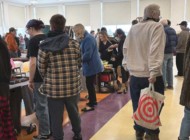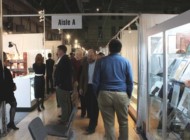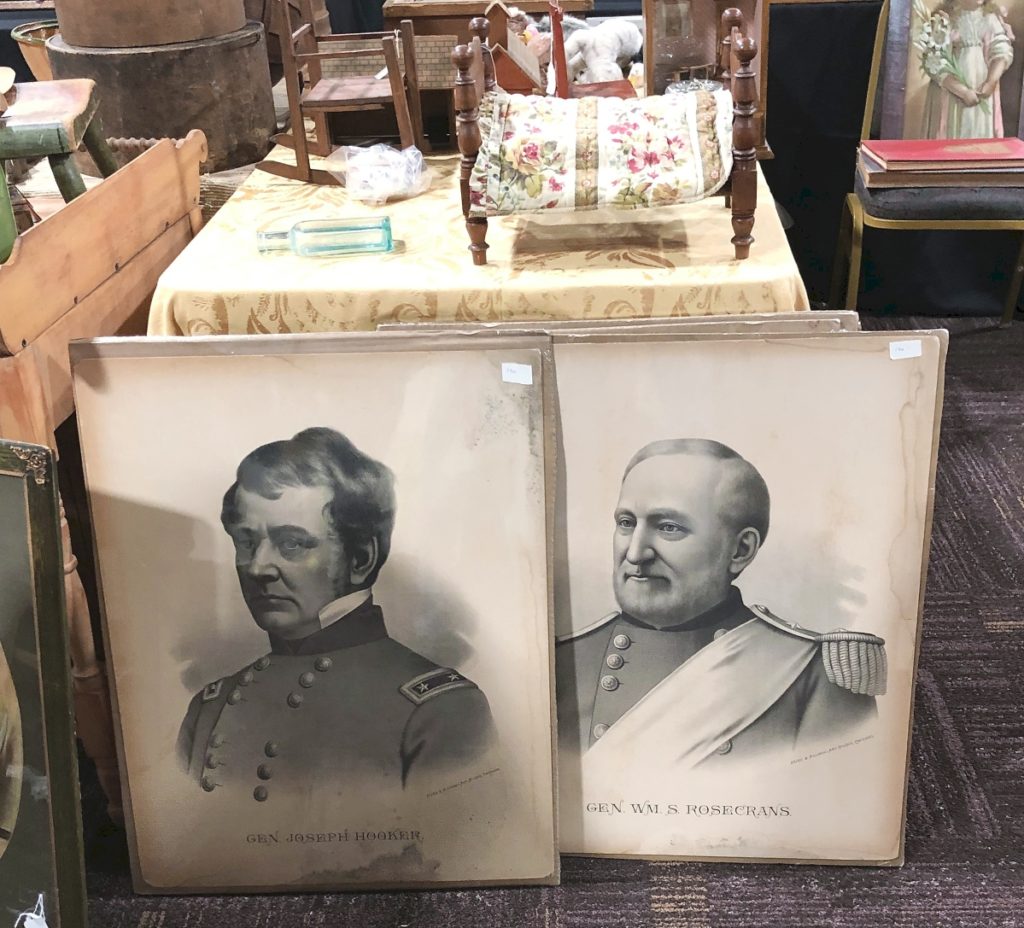
Mickey Novak, J&M Antiques, Monson, Mass., had several large shrink-wrapped lithographs, including one of Civil War generals, priced $140 each.
Review and Photos by Rick Russack
STURBRIDGE, MASS. – Showgoers on New Year’s Day used to have multiple shows from which to choose. But for one reason or another, those other shows are gone or were not scheduled this year. So the Antiques and Collectibles Show in Sturbridge, run by Maxine Carter-Lome, was definitely the place to be. Carter-Lome and her husband Jeff also own the Weathervane Publishing Company, publishers of The Journal of Antiques and Collectibles. They have taken advantage of the situation, and their Sturbridge show is now in its third year. They live in Sturbridge, where Carter-Lome is heavily involved with promotion of the Brimfield shows, knows the area and the dealers well and saw the opportunity for a successful New Year’s Day show.
The show had 50 dealers. Carter-Lome’s floor plan allowed for wide aisles and large booths. She said, “I really wanted it to be airy and for people to have space.” As it turned out, that was good thinking. The crowd waiting for the show to open was huge. One comment from a veteran show-attendee summed it up, “I don’t think I’ve ever seen a line like this.” Once open, aisles and booths filled quickly. The operative word in that sentence is “filled.” Also filling quickly were shopping bags. Prior to the show, Carter-Lome said, “I wanted a show with dealers that I knew would offer a wide selection of merchandise at reasonable prices. I wanted to be sure that buyers with limited amounts of money to spend would have fun things to look at. Exhibitors understood that we weren’t expecting many customers looking to spend $3,000 or $5,000. So that’s what we had: 50 dealers with varied, affordable antiques and collectibles. One result was that several dealers told me that their pre-show buying and selling was strong.” There was plenty of stoneware, painted woodenware, toys, jewelry, silver, ceramics, Christmas collectibles and more. Specialist dealers filled booths with American glass, Shaker smalls, decoys and more. Offerings ranged from Eighteenth Century iron and metal to Twentieth Century items. However, points for the oldest items in the show would probably go to a pair of polished agate bookends or a boxful of fossils.
The first item you would have seen as you entered the show looked like a church-style pipe organ, but it wasn’t. Ernie Eldridge, Windham, Conn., said that he thought it may have been made to be placed on top of a home organ to give the appearance of it being a pipe organ. He was marketing it “creatively,” portraying it as useable for a home bar, with cocktail shakers and glasses on its shelf. And he priced it very inexpensively at $265. The cocktail shaker sets were $40 each.
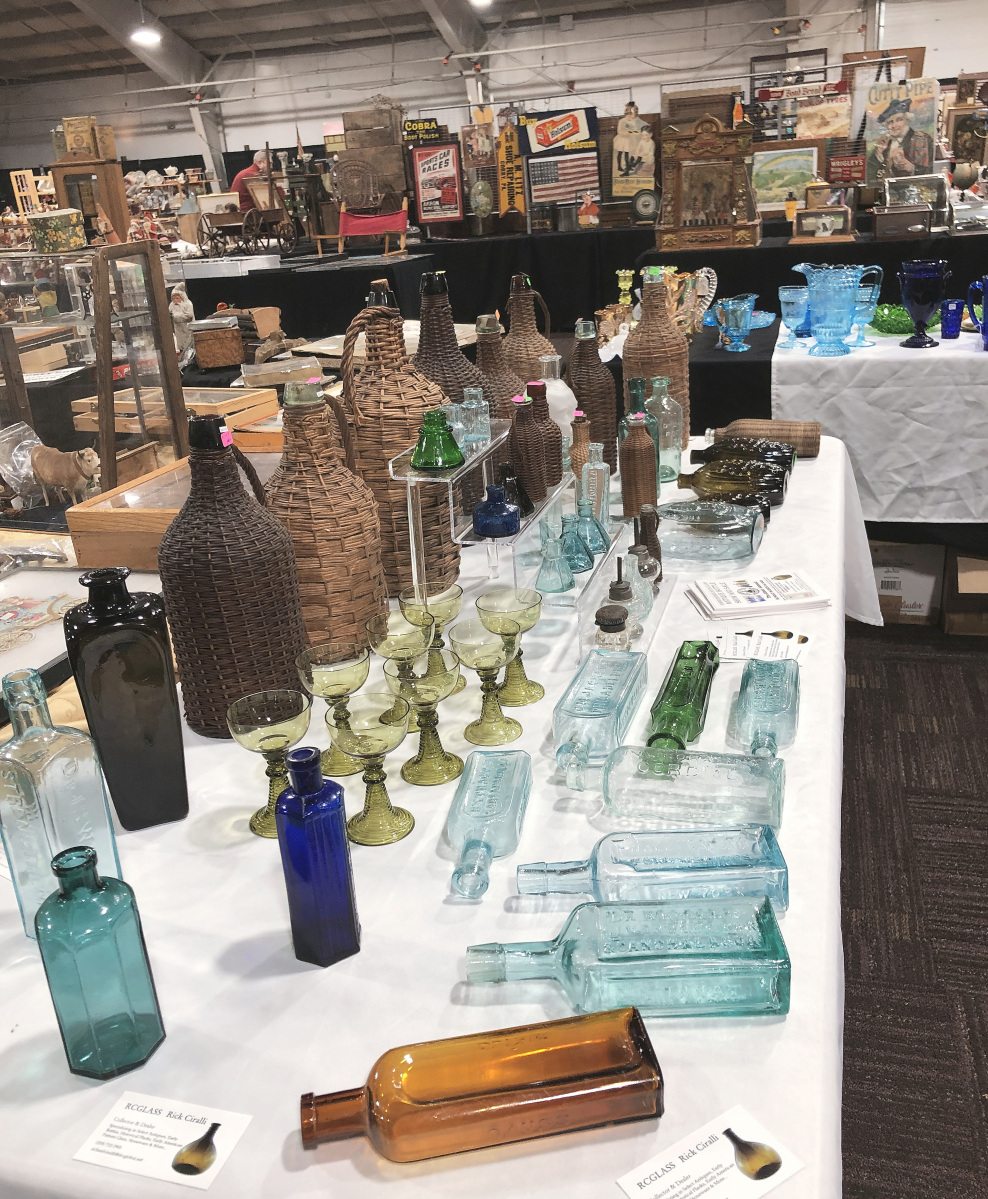
Rick Ciralli, RCC Glass, Bristol, Conn., had nothing but glass in his booth. The early medicine bottles, inks and flasks ranged in price from $175 to $400.
Across the aisle from the “bar” was a large wooden rocking horse in the booth of Joyce Haddad. She priced it $675. She was one of the dealers with a selection of stoneware. Mark Marinos, Marblehead, Mass., was one of the dealers with a selection of Roseville pottery and Fiesta dinnerware. His Roseville was priced between $20 and $50 and his colorful selection of Fiesta started at $10. John and Fran Gintoff, East Hampton, Conn., also had some pottery. Their selection of midcentury pottery included pieces made in the former West Germany. There was an active studio pottery movement in West Germany prior to the 1990 reunification. Their offerings also included Twentieth Century decorative arts – paintings, glassware and metalware.
Tom Reiley, Glastonbury, Conn., collects, buys and sells decoys. He also produces decoy shows with about 20 dealers to get their offerings in front of an interested crowd. His next Antiques and Outdoor Sporting Goods Show will be in Westbrook, Conn., May 20. There was almost nothing in his booth but decoys – full tables overflowing to some in canvas bags on the floor. Prices began at $50. He said that his most desirable bird was a plover made by Lathrop Holmes (1824-1899), a talented Massachusetts carver whose works have often brought five-figure prices at decoy auctions. He was asking $2,750 for the plover.
Early games and toys were available in several booths. Mickey Novak, J&M Antiques, Monson, Mass., was asking $145 for a colorful Nineteenth Century puzzle-game of Sliced Birds. He had assembled each of the sets and covered them with shrink wrap. The passenger pigeon puzzle was very colorful, but Novak said that the bird did not really show those colors. His large ADT Messenger boxed game, published by Milton Bradley, was priced $145 and McLaughlin’s District Messenger board game was priced $160. He had several more from which to choose. Robert Nance, Hazelton, Penn., had a large, elaborate, late Nineteenth Century toy theater. The proscenium was labeled “Opera House” and it had multiple lithographed sets of scenery. It was in good condition and was priced $750.
There was not a lot of formal furniture on the floor but Joe Collins, Middletown, Conn., had a late Eighteenth Century tall case clock, with brass works for which he was asking $1,400. He thought it had originated in Connecticut. He also offered a selection of candlestands, a Chinese export porcelain covered tureen and some early American portraits. A pair depicting Amelia Wells and her child in a red dress was priced $1,100. Included with the portraits was a sampler by Wells. According to a plaque on her portrait, it was done by C.K. Palmer in 1841. He was active in the first half of the Nineteenth Century but little is known about him.
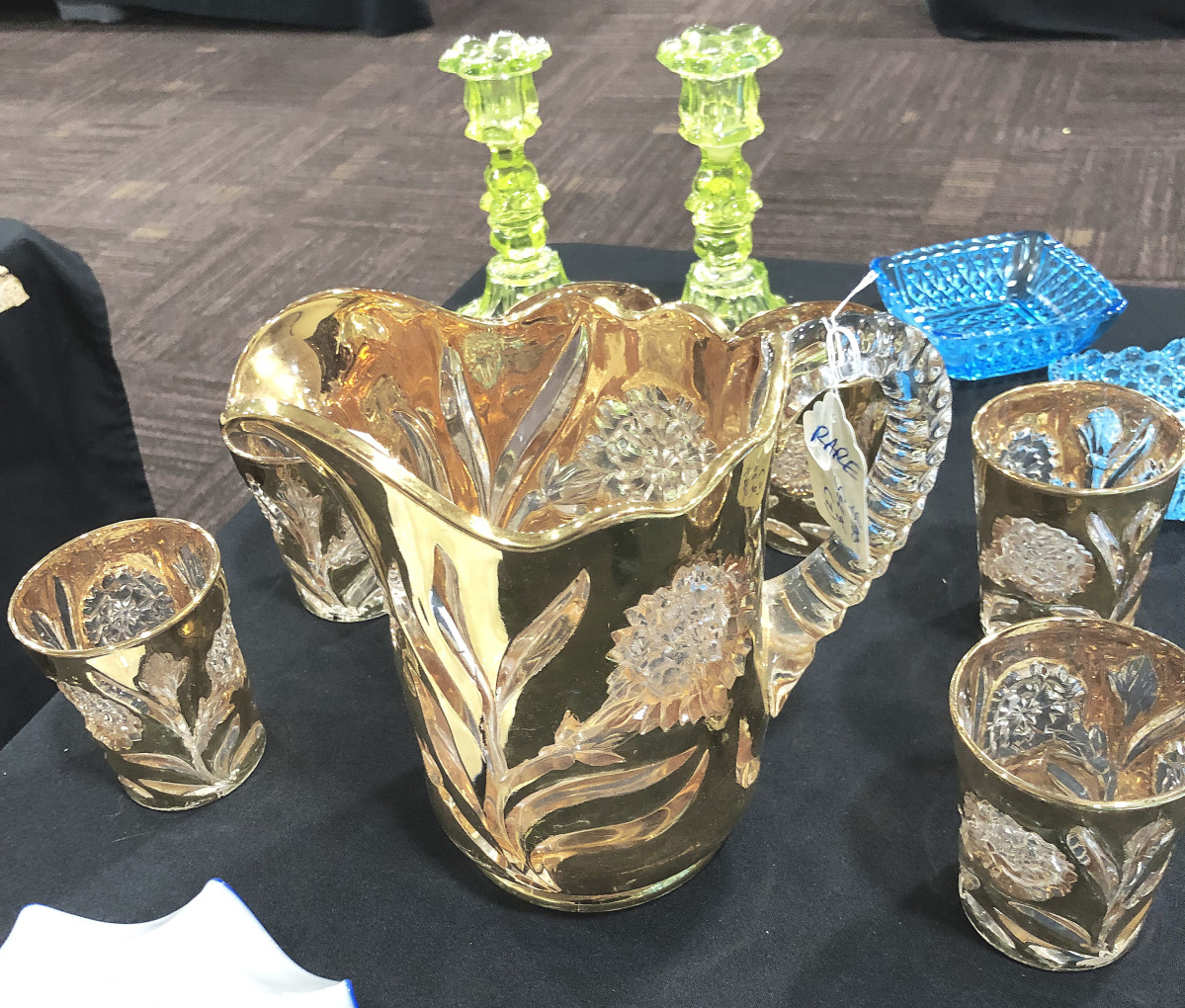
Rick Ciralli offered a wide selection of pattern glass, both clear and colored. He especially liked this gilded Carnation pattern set of glasses and matching pitcher made by the New Martinsville Glass Company. The gilding was in perfect condition, showing no signs of wear. Ciralli said he thought it might have been a wedding gift and spent its entire life in a cabinet, never having been used. The price was $785.
In days gone by, indoor shows in Connecticut and Massachusetts used to have several specialist dealers with booths full of early American pattern glass. There seems to be fewer specialist show dealers today, but the field is alive and well, and new collectors are learning and building collections. Rick Ciralli, Bristol, Conn., had a booth with nothing but glass: medicine bottles, inks, flasks and both clear and colored pattern glass. He took a few minutes to talk about the pattern glass market today. “I know that you may not see as much at some shows as you used to but the interest in early American pattern glass is strong and growing. A lot of activity is online coordinated by the Early American Pattern Glass Society. For more than 20 years they’ve been publishing a quarterly journal, with informative articles and news about upcoming shows. The group’s website has other resources for collectors, probably the most important of which is a database for pattern identification. The society is active on social media platforms, supporting both new and veteran collectors. It also lists reputable auction houses and dealers who are members of the society. It really encourages new collectors, many of whom have inherited glass and want to know more about it.” [A quick visit to the website indicates that there is a database identifying more than 7,000 patterns and with more than 60,000 photos of individual pieces.] Ciralli commented that many of the new generation of collectors are drawn to colored glass, such as Vaseline glass, of which he had several pieces.
A few days after the show, Carter-Lome said there were more than 850 paid admissions. “That’s really great these days, and several dealers told me that they had a very good show. I was glad to hear that. Some of our dealers, especially the older ones, have cut back their show schedules so that they’re only doing one or two shows a year now, so they were showing merchandise that has not been seen for a while, much of it from long-time personal collections. They were able to get the year off to a good start. The crowd was steady all day and so was the stream of people leaving with packages. I also saw a number of small pieces of furniture going out, especially painted country things.”
For more information, 508-347-1980 or www.theantiquecollectiblesshow.com.



























